
Kalanchoe thyrsiflora
Do you like succulents or succulents not cacti? If so, and you do not have much experience and / or you would like to have very low maintenance species, without a doubt we recommend you to Kalanchoe. There are many types, and each of them has something that makes them unique. In some, it is the color of its leaves, in others it is its beautiful flowers. However, the vast majority of them can be used to decorate any bright corner, both from the garden and the home.
In addition, there are species that are medicinal. What more could you want? A care guide? That is done! Although you will not only learn to take care of them, but after reading it you will discover things that, probably, you did not know about the Kalanchoe.
Origin and characteristics of the Kalanchoe
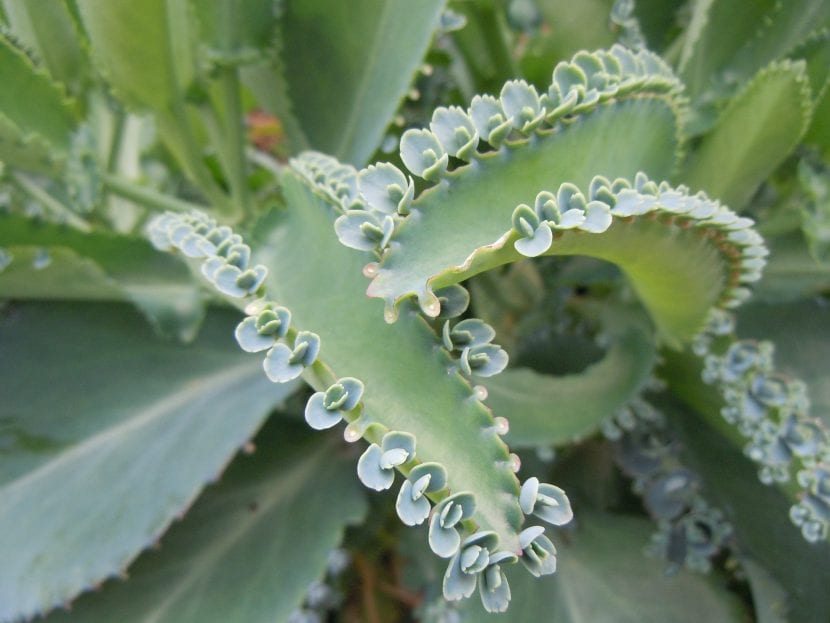
Kalanchoe schizophylla
The Kalanchoe are native to the hot regions of the world. Mainly, they are found on the African continent and Madagascar. The genus is made up of about 125 species, which are shrubs or perennial herbaceous plants, with a few being annual or biennial. They are characterized by having fleshy, medium to dark green leaves, covered by something similar to wax, which form rosettes. From each of them flower stems emerge during winter and spring. The flowers can be red, pink, yellow, white or purple, and they have no scent.
But If there is something that distinguishes many Kalanchoe, it is their tendency to produce suckers on the edges of their leaves.. These suckers are exact replicas of the plant that has produced them. Once they grow a little and have their own roots, they fall, and if there is soil, they immediately take root. In this way, the survival of the species is ensured, since although they also multiply by seeds, they need more time to germinate than the suckers need to grow.
Main types or species
Of the more than a hundred species that exist, there are really few that are cultivated. Luckily, it is possible to have a very nice collection in our garden or on the balcony. Take a look at the most popular species:
Kalanchoe beharensis
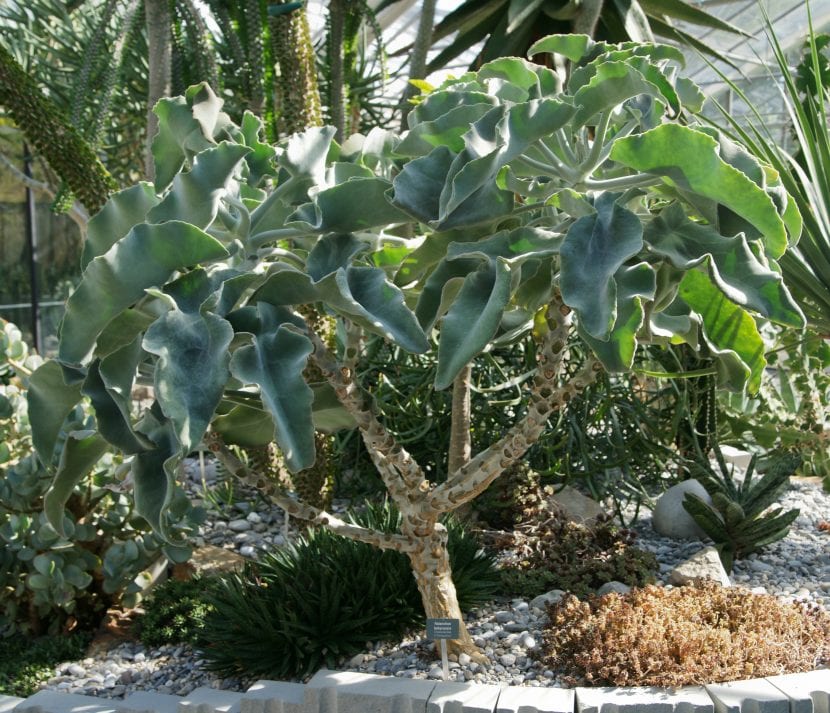
It is a species native to Madagascar known as Elephant Ear that grows to a height of 3 meters, which makes it the highest of the genre. Its leaves are triangular-lanceolate with margins that have a double scallop. These are olive green in color and covered by fine tan or bluish hairs on both sides. The flowers bloom in early spring and are yellowish-green. Resists frost down to -2ºC.
Kalanchoe blossfeldiana
It is a plant native to Madagascar that grows to 40cm tall. Its leaves are fleshy, glossy dark green. Its flowers are grouped in red, purple, orange, yellow or white clustered inflorescences in late spring. Does not resist frost.
Kalanchoe daigremontiana
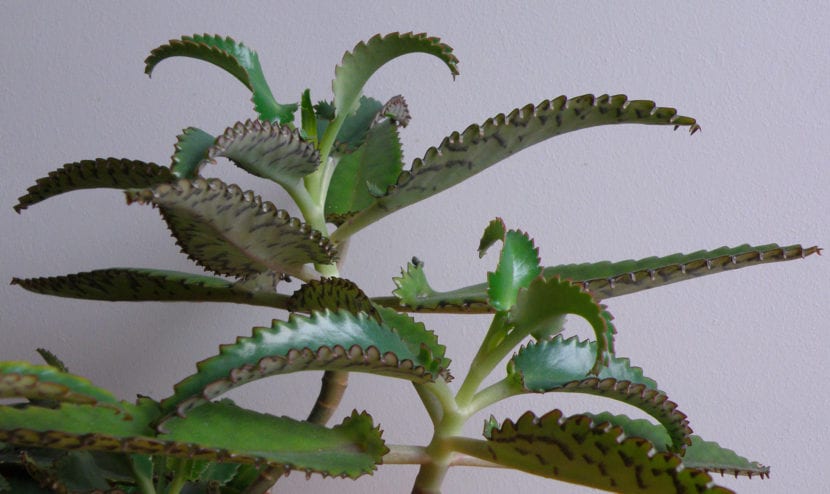
It is a plant native to Madagascar known as Aranto or Devil's backbone that reaches a height of up to 1m. Its leaves are lanceolate, with a serrated edge, a bright green upper surface and a green underside with black spots. It does not usually flower, but when it does, it develops a cluster-shaped inflorescence composed of pink flowers. Resists cold and mild frosts down to -2ºC.
Want a? Buy it here.
Kalanchoe pinnata
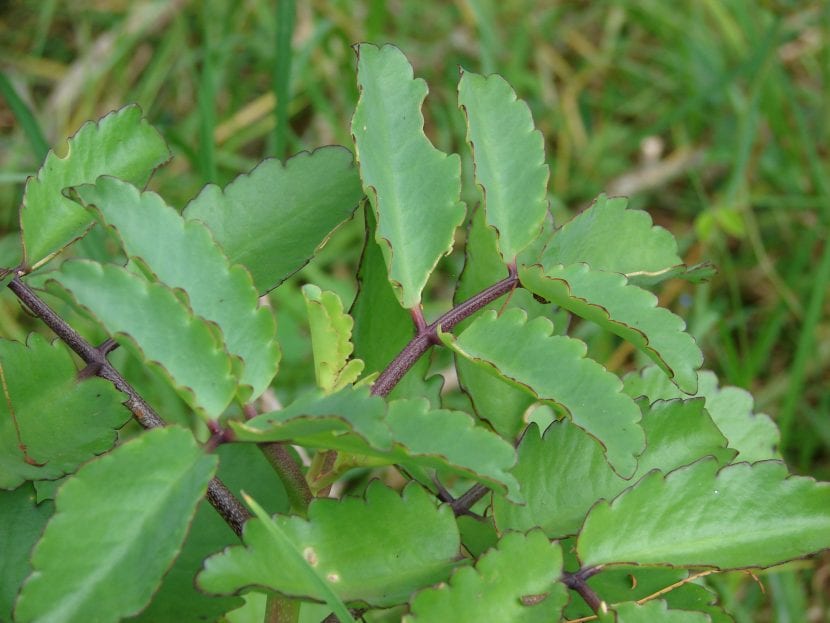
Known as »air leaf», it is a species native to India and Madagascar that grows to a height between 30cm to 1m. It has pinnate leaves, which is what gives it its name, with serrated margins. Its stems are of an intense purple color. It produces inflorescences with green, yellow or reddish flowers. It is sensitive to frost.
Kalanchoe thyrsiflora
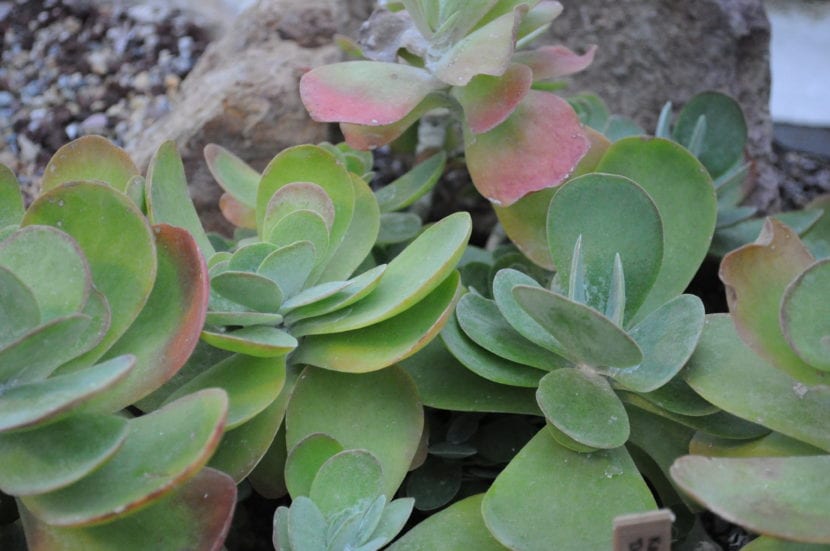
It is a plant native to South Africa and Lesotho formed by rosettes of rounded leaves with a smooth margin that reach 40-50cm in height. These are green, but the more exposed to the sun they are more pink-reddish they become. Its flowers are grouped in erect inflorescences and are green with yellow recurve lobes. It blooms from fall to spring. Resists frost down to -2ºC.
Do not miss yours. Click here.
What care do you need?
Are you liking these succulent plants? If so, surely you are thinking of purchasing a copy, right? Give it these cares so that you can enjoy it to the fullest:
- Location: Most of the species found in nurseries need to be in a very bright area, even in full sun. Just the Kalanchoe blossfeldiana you will appreciate being in semi-shade.
- Irrigation: scarce. During the summer it should be watered once or twice a week, and the rest of the year every 10-15 days.
- Subscriber: in spring and summer it must be paid with fertilizers for cacti and succulents, following the instructions specified on the packaging (get it by clicking on this link).
- Soil or substrate: It is not demanding, but it must have good drainage, otherwise its roots will rot, like this for instance. you have more information here.
- Planting or transplanting time: in spring, when the risk of frost has passed.
- Multiplication:
- Seeds: sow them in a seedbed in spring or summer with vermiculite (for sale here). Cover them with a very thin layer of this substrate and always keep them slightly humid (not flooded). They will germinate after a month.
- Stem cuttings: Take a stem cutting in the spring or summer and plant it in a pot or elsewhere in the garden. Take care of it as if it were already a plant with roots, as it will not take more than a couple of weeks to take root.
- Youngsters: you can separate them from the mother plant when they have their first roots, and plant them in small pots until they grow. You can use universal cultivation substrate, although I recommend covering their roots with river sand or pumice, because as they are so small, it is sometimes very difficult to plant them correctly.
- Plagues and diseases: basically snails and slugs. Mollusks are your enemy. You can keep them away from your Kalanchoe with diatomaceous earth (for sale here). Put it on the substrate or the ground, around the plant, and so they will not bother. The dose is 30g per 1l of water. In case you can't get it, Click here to know what other natural remedies there are against these animals.
- Rusticity: some species, as we have seen, support mild frosts, but it is better to protect them from the cold and, above all, from hail.
What are the Kalanchoe used for?

Ornamental
Kalanchoe are very pretty plants that they are wonderful planted anywhere. The color of its leaves and its precious flowers make its ornamental value very high. In addition, many species, being small, can be used to create compositions, both with other Kalanchoe and with other flowering plants.
Medicinal
Although most species are toxic, there are others that, used correctly, can help us improve health. Such is the case of Kalanchoe pinnata, Kalanchoe daigremontiana y Kalanchoe Gastonis-bonnieri. Its leaves can be prepared to apply externally or internally. For external use, they are used by making plasters or poultices, and for internal use you can prepare an infusion or add the leaves to dishes such as salads. The dose is as follows:
- Internal use: 30 grams of fresh leaf per day.
- External use: 1 to 3 fresh leaves.
The benefits it has are the following- Relieves rheumatism and cough, is sedative, cuts diarrhea, improves digestion, can be used as a complementary cancer treatment, reduces fever and protects the liver.
What are its contraindications?
They cannot be used during pregnancy, or for long periods of time. You should not abuse the plant or consume doses of 5 grams of plant per kilo of weight (which would be about 350 grams of leaves for a person weighing 70 kg, which is a dose four to ten times higher than recommended).
Consult with your doctor if you have any questions.
And with this we are done. What did you think of the Kalanchoe?




The note has seemed wonderful to me, I had been looking for information that would help me have my calanchoes splendid, thank you very much!
We are glad you liked it. All the best.
Ana, very much in agreement with you, these tips help me to take care of and reproduce my calanchoes; I have many friends who buy them for me
The whole note was very useful to me, thank you for giving us this info.
Thank you very much, Maria Jose. Greetings!
I love Kalanchoes especially the ones with their little children on the leaves
Hello rosa.
They are wonderful, yes.
A greeting.
I have had two kinds of kalanchoe for years, and they reproduce by suckers .... I use it for infections, external use. I didn't know about its other properties, that's why I read the article. Very good . Thanks .
Hello Graciela.
Kalanchoe are very pretty plants, but beware of using them for anything other than decorative, just in case.
Greetings.
I have it in my garden and I am happy for the report of it, I liked it for its little roses on the edge, I did not imagine that it was curative, thanks now I will take care of it with more love
We are glad you liked it, Palmira.
I have many in my garden, they reproduce easily when the plants that grow on the edge of their leaves fall.
Without a doubt, they are one of the easiest plants to multiply 🙂
I find the advice excellent and to learn more about
this plant
Hello Herminia.
Thank you very much for your words. We are happy to hear that the tips have been helpful to you.
Greetings.
So far I have informed myself that this plant is medicinal, it is interesting, thanks for the information, and I also like to have it in my garden.
We're glad you found it interesting, Dadsy 🙂
In my country El Salvador they call her a bad mother and she is beautiful and has many benefits.
Hello. I have in my garden the Kalanchoe daigremontiana type. I knew it was medicinal but not the recommended dosage. Thanks
Good morning if I give you one at home here in the Dominican Republic they call it a bad mother, how should I use it as a tee?
Personally, I love that plant, I like all the suckers that grow on its leaves, but since they multiply so much, I reseed them and give them away. Thanks Nature, !!!
You do well. This plant produces many suckers, and surely more than one loves to receive them as gifts 🙂
Excellent explanation I have several types and I love them !! And I take care of them a lot I love them
Very well and easy explained to understand everything !! We love you calachoe and the succulents
Thank you very much, Alicia. 🙂
Enjoy your plants!
I really liked the explanation and it is a plant that I like very much and I have several graces they are geniuses
Hello Maria.
Perfect, thank you very much for your words 🙂
Excellent information
I have two varieties, they are beautiful, the children fall, it happened to me, a cement patio there is a small crack there I have a plant I love
Thank you very much, Alejandra. We are glad to know that you liked the article 🙂
Excellent, magnificent, thank you very much.
Thank you very much, Ernesto. We're glad you liked it.
I love. I have some of them. I would like to have much more. Here in Chile they reproduce very well.
Thank you.
Hello Maria Graciela.
They are undoubtedly very grateful plants. We are in Spain and I can't tell you where they sell in Chile, but if you ask a plant nursery, they may be able to inform you.
Regards!
They look like beautiful plants
We agree 🙂
I found outside my house the kalanchoe plant that has its very small plants on the shore and today it has grown and multiplied into several plants because when they fall there they grow, I take care of it so much that I would like to know what care I can give it.
Hi Ines.
From what you can tell, you're already providing him with the care he needs. Anyway, in the article we talk about them.
A greeting.